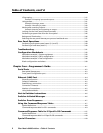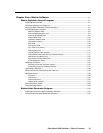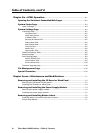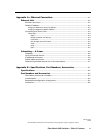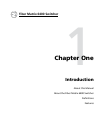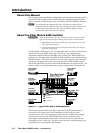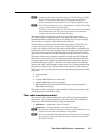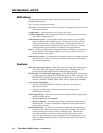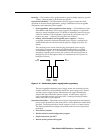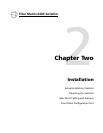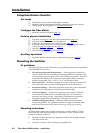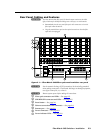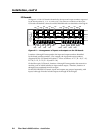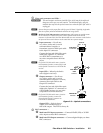
Introduction, cont’d
Fiber Matrix 6400 Switcher • Introduction
1-4
Definitions
The following terms, which apply to all Extron matrix switchers, are used
throughout this manual:
Tie — An input-to-output connection.
Set of ties — An input tied to two or more outputs. (An output can never be tied to
more than one input.)
Configuration — One or more ties or one or more sets of ties.
Current configuration — The configuration that is currently active in the switcher
(also called “configuration 0”).
Global memory preset — A configuration that has been stored. Up to 64 global
memory presets can be stored in memory. When a preset is retrieved from
memory, it becomes the current configuration. Presets can be saved and
recalled from the front panel and any of the serial or LAN ports. For front
panel operations, preset locations are assigned to the input buttons.
Room — A subset of outputs that are logically related to each other, as determined
by the operator. The switchers support up to 10 rooms, each of which can
consist of from 1 to 64 outputs.
Room memory preset — A configuration consisting of outputs in a single room that
has been stored. When a room preset is retrieved from memory, it becomes
the current configuration.
Features
Fiber optic inputs and outputs — With fiber optic I/O boards, the switchers input
and output fiber optic signals on optical connectors. The fiber optic I/O
boards support digital signals from 270 Mbs through 4.25 Gbps.
SDI, HD-SDI, or 3G-SDI inputs and outputs — With SDI/HD-SDI I/O boards, the
switchers input and output SDI and HD-SDI signals on BNC connectors. The
SDI/HD-SDI I/O boards support multi-rate SDI at rates up to 2.97 Gbps, and
comply with SMPTE 259M-C, 292M, 424M, and ITU digital video standards.
Cross-format compatibility —
• AninputonanSDI/HD-SDII/Oboardcanbetiedtoanoutputona
fiber optic I/O board.
• AninputonaberopticI/Oboardcanbetiedtoanoutputonan
SDI/HD-SDI I/O board.
Switching flexibility — The switcher provides individually buffered, independent
matrix switched outputs.
• Tie any input to any or all outputs.
• Quick multiple tie — Multiple inputs can be switched to multiple outputs
simultaneously. This allows all displays (outputs) to change from source to
source at the same time.
Input link detection — In critical environments or unmanned, remote locations,
it may be vital to know that sources are active and switching. The switcher
confirms that input sources are active by detecting light. Link detection
provides instantaneous feedback via the switchers’ serial ports or LAN
port. The input information can be displayed on any control system or in a
Windows-based control program on a local-area network (LAN) or Internet
(IP) connection.



